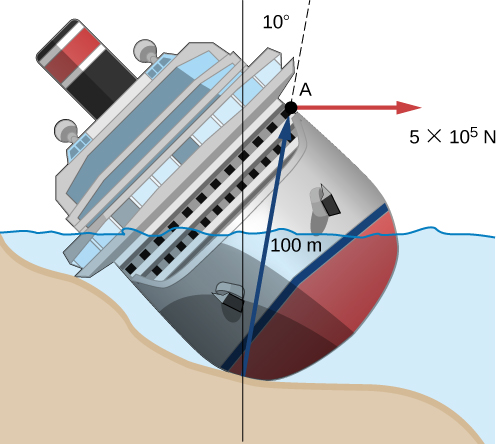10.6 Torque
Learning Objectives
By the end of this section, you will be able to:
- Describe how the magnitude of a torque depends on the magnitude of the lever arm and the angle the force vector makes with the lever arm
- Determine the sign (positive or negative) of a torque using the right-hand rule
- Calculate individual torques about a common axis and sum them to find the net torque
An important quantity for describing the dynamics of a rotating rigid body is torque. We see the application of torque in many ways in our world. We all have an intuition about torque, as when we use a large wrench to unscrew a stubborn bolt. Torque is at work in unseen ways, as when we press on the accelerator in a car, causing the engine to put additional torque on the drive train. Or every time we move our bodies from a standing position, we apply a torque to our limbs. In this section, we define torque and make an argument for the equation for calculating torque for a rigid body with fixed-axis rotation.
Defining Torque
So far we have defined many variables that are rotational equivalents to their translational counterparts. Let’s consider what the counterpart to force must be. Since forces change the translational motion of objects, the rotational counterpart must be related to changing the rotational motion of an object about an axis. We call this rotational counterpart torque.
In everyday life, we rotate objects about an axis all the time, so intuitively we already know much about torque. Consider, for example, how we rotate a door to open it. First, we know that a door opens slowly if we push too close to its hinges; it is more efficient to rotate a door open if we push far from the hinges. Second, we know that we should push perpendicular to the plane of the door; if we push parallel to the plane of the door, we are not able to rotate it. Third, the larger the force, the more effective it is in opening the door; the harder you push, the more rapidly the door opens. The first point implies that the farther the force is applied from the axis of rotation, the greater the angular acceleration; the second implies that the effectiveness depends on the angle at which the force is applied; the third implies that the magnitude of the force must also be part of the equation. Note that for rotation in a plane, torque has two possible directions. Torque is either clockwise or counterclockwise relative to the chosen pivot point. Figure 10.31 shows counterclockwise rotations.
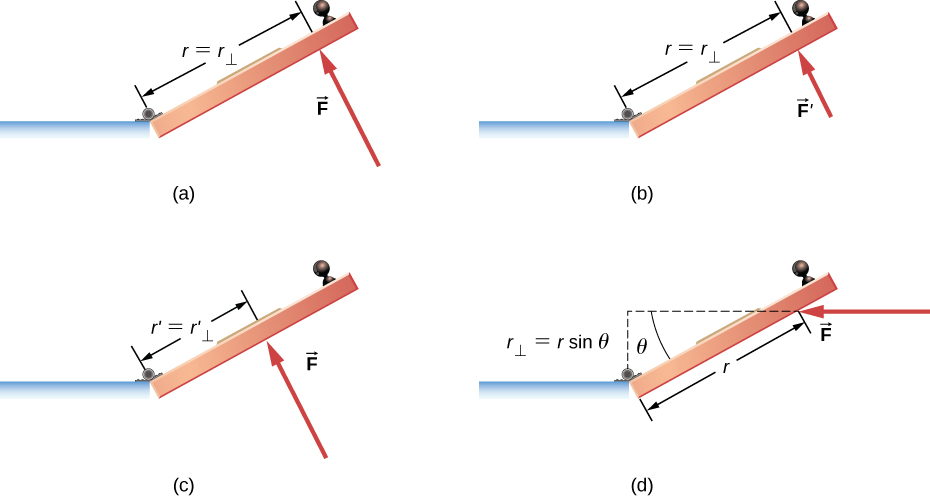
Now let’s consider how to define torques in the general three-dimensional case.
Torque
When a force is applied to a point P whose position is relative to O (Figure 10.32), the torque around O is
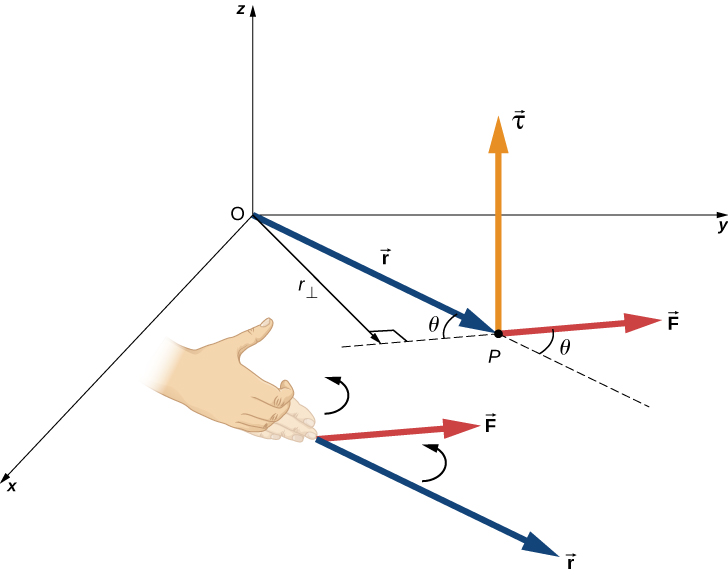
From the definition of the cross product, the torque is perpendicular to the plane containing and has magnitude
where is the angle between the vectors and . The SI unit of torque is newtons times meters, usually written as . The quantity is the perpendicular distance from O to the line determined by the vector and is called the lever arm. Note that the greater the lever arm, the greater the magnitude of the torque. In terms of the lever arm, the magnitude of the torque is
The cross product also tells us the sign of the torque. In Figure 10.32, the cross product is along the positive z-axis, which by convention is a positive torque. If is along the negative z-axis, this produces a negative torque.
If we consider a disk that is free to rotate about an axis through the center, as shown in Figure 10.33, we can see how the angle between the radius and the force affects the magnitude of the torque. If the angle is zero, the torque is zero; if the angle is , the torque is maximum. The torque in Figure 10.33 is positive because the direction of the torque by the right-hand rule is out of the page along the positive z-axis. The disk rotates counterclockwise due to the torque, in the same direction as a positive angular acceleration.
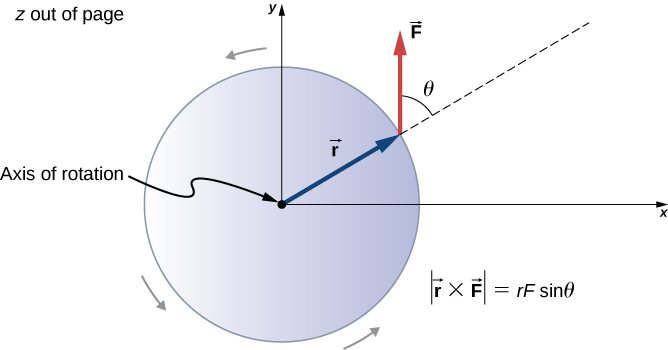
Any number of torques can be calculated about a given axis. The individual torques add to produce a net torque about the axis. When the appropriate sign (positive or negative) is assigned to the magnitudes of individual torques about a specified axis, the net torque about the axis is the sum of the individual torques:
Calculating Net Torque for Rigid Bodies on a Fixed Axis
In the following examples, we calculate the torque both abstractly and as applied to a rigid body.
We first introduce a problem-solving strategy.
Problem-Solving Strategy
Finding Net Torque
- Choose a coordinate system with the pivot point or axis of rotation as the origin of the selected coordinate system.
- Determine the angle between the lever arm and the force vector.
- Take the cross product of to determine if the torque is positive or negative about the pivot point or axis.
- Evaluate the magnitude of the torque using .
- Assign the appropriate sign, positive or negative, to the magnitude.
- Sum the torques to find the net torque.
Example 10.14
Calculating Torque
Four forces are shown in Figure 10.34 at particular locations and orientations with respect to a given xy-coordinate system. Find the torque due to each force about the origin, then use your results to find the net torque about the origin.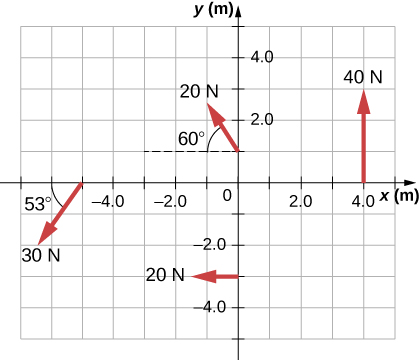
Strategy
This problem requires calculating torque. All known quantities––forces with directions and lever arms––are given in the figure. The goal is to find each individual torque and the net torque by summing the individual torques. Be careful to assign the correct sign to each torque by using the cross product of and the force vector .Solution
Use to find the magnitude and to determine the sign of the torque.The torque from force 40 N in the first quadrant is given by .
The cross product of and is out of the page, positive.
The torque from force 20 N in the third quadrant is given by.
The cross product of and is into the page, so it is negative.
The torque from force 30 N in the third quadrant is given by .
The cross product of and is out of the page, positive.
The torque from force 20 N in the second quadrant is given by .
The cross product of and is out of the page.
The net torque is therefore
Significance
Note that each force that acts in the counterclockwise direction has a positive torque, whereas each force that acts in the clockwise direction has a negative torque. The torque is greater when the distance, force, or perpendicular components are greater.Example 10.15
Calculating Torque on a rigid body
Figure 10.35 shows several forces acting at different locations and angles on a flywheel. We have , , and . Find the net torque on the flywheel about an axis through the center.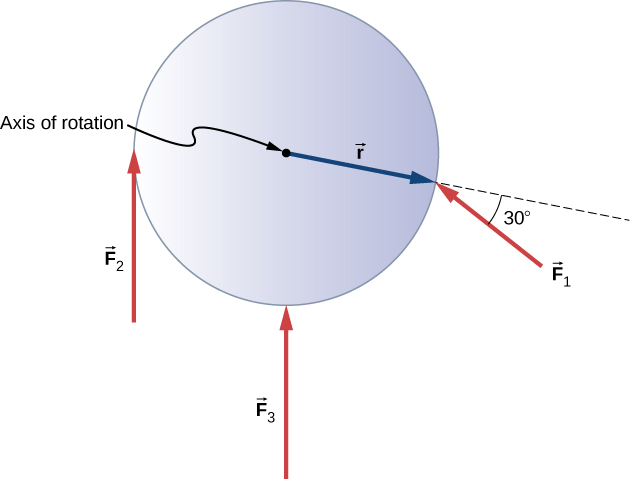
Strategy
We calculate each torque individually, using the cross product, and determine the sign of the torque. Then we sum the torques to find the net torque.Solution
We start with . If we look at Figure 10.35, we see that makes an angle of with the radius vector . Taking the cross product, we see that it is out of the page and so is positive. We also see this from calculating its magnitude:Next we look at . The angle between and is and the cross product is into the page so the torque is negative. Its value is
When we evaluate the torque due to , we see that the angle it makes with is zero so Therefore, does not produce any torque on the flywheel.
We evaluate the sum of the torques:
Significance
The axis of rotation is at the center of mass of the flywheel. Since the flywheel is on a fixed axis, it is not free to translate. If it were on a frictionless surface and not fixed in place, would cause the flywheel to translate, as well as . Its motion would be a combination of translation and rotation.Check Your Understanding 10.6
A large ocean-going ship runs aground near the coastline, similar to the fate of the Costa Concordia, and lies at an angle as shown below. Salvage crews must apply a torque to right the ship in order to float the vessel for transport. A force of acting at point A must be applied to right the ship. What is the torque about the point of contact of the ship with the ground (Figure 10.36)?
